This page contains
1. Basics
2. Flowering
1. Basics to growing Cymbidium
Cymbidiums are a wonderful plant. The ability to regenerate each year and give endless reward should not be underestimated. We have plants of Cym. Dr Lloyd Hawkinson ‘Piedmont’ in our nursery that have been in production for over 30 years.
Here are a few simple pointers to getting the best from your cymbidium.
- 1. Give it lots of light.
- Cymbidiums like as much light as you can give them without burning the leaves. At our previous location we grew under 30% shade cloth. The leaves would get sunburned in summer, but every plant flowered. Getting a location with more light rather than less will help a great deal in initiating flower spikes.
- 2.Keep it moist.
- Traditional Cymbidiums originated from species collected from the Himalayan region. This is a monsoon climate, with a rainy season and a dry. The plants have evolved to store moisture in the pseudo bulbs. They also have their roots inside the tree in the rotten centre. This is a very important aspect to their happiness.
- 3.Leave it alone.
- A cymbidium plants works as a whole, with the backbulbs supporting the green bulb and the new growing lead. It is very important to keep this clump connected. Division or breaking up is not in the best interests of re-flowering your cymbidium. Where possible, pot on rather than dividing your plant. Our inert media helps with this process as it does not break down.
This is the basics of Cymbidium culture to get you started.
2. Flowering Cymbidiums
One of the questions we are asked on a regular basis is "Why didn't my Cymbidium flower?" There are few plants that take as much planning a Cymbidium does to achieve flowering. We have covered the basics to help new growers succeed above.
As recent night temperatures have begun to drop, your Cymbidium has already started preparing for it's 2021 blooming! The overall process for setting spikes has begun and it is a relatively complicated one. Through mistakes, disasters and a lot of experience we have arrived at the following summary of the spike initiation process at our nursery.
1, Start of Autumn. The plant should be in a low nitrogen state. This means that you should use a flower booster (10:30:20) from the beginning of Autumn to the end of the initiation period.
2. Mid Autumn. This is when our night temperatures tend to drop below 13 degrees Celsius. This temperature threshold, which should last a minimum of three months, is crucial for the spike setting of traditional Cymbidiums. The longer the temperature is below 13 degrees each evening, the greater the chances of success. At our location, this is achieved naturally and the temperature requirements continue until mid-October.
3. Mid-Winter. We begin stripping the plants at the conclusion of flowering, as the plant requires higher light levels from post-flowering until summer. We use the stripping method shown on the video page in the grower resource. Remember that leaves on the green-bulbs have as much to do with flowering as the new ones do, and only take off what is needed. It's also important to remember to give multiple plants enough space between each another to allow light into them.
Once the night temperatures rise above 13 degrees, the plant no longer requires the low nitrogen state. It's time to return to a 20-20-20 or even a 27-15-12 for the warmer months.
Each part of the process is important. Remember, low nitrogen, low temperature and good light during initiation are key to a successful flowering.







